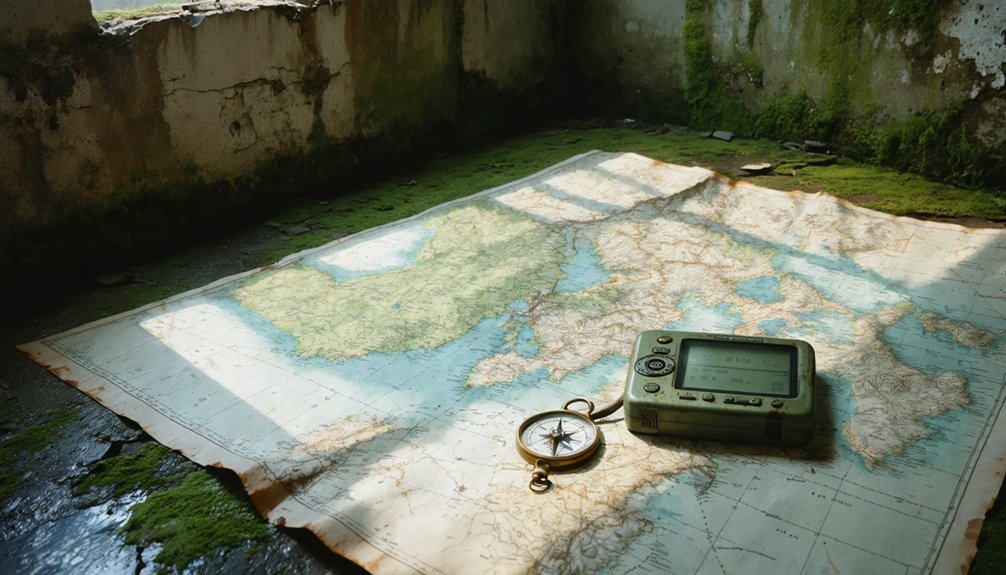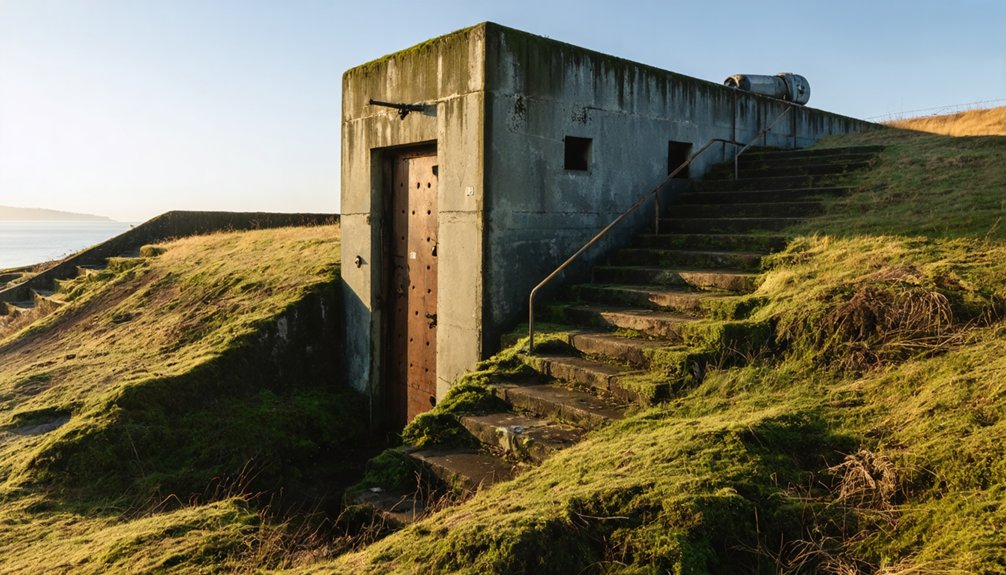When exploring abandoned military camps, you’ll need to: research the site’s history thoroughly, obtain proper legal permissions, carry essential safety gear, learn to identify explosive hazards, use reliable navigation tools, document findings without removing artifacts, and assess structural dangers before entry. Always maintain communication protocols with emergency contacts and wear appropriate protective equipment. These precautions form the foundation for responsible exploration, with critical details on each practice awaiting your discovery below.
Key Takeaways
- Always obtain proper legal permissions before visiting abandoned military sites to avoid federal trespassing violations.
- Wear appropriate protective gear including sturdy footwear, gloves, and respiratory protection for potential hazards.
- Research the site’s history and potential dangers like unexploded ordnance, structural instability, and hazardous materials.
- Establish emergency protocols with reliable navigation tools and communication devices before exploration.
- Document findings ethically through photography and notes without disturbing artifacts or removing items from the site.
Research the Site’s History and Status Before Visiting
Before commencing any exploration of abandoned military installations, thorough research into the site’s history and current status is essential.
Begin by consulting official government websites and military archives that document the camp’s establishment, operational timeline, and decommissioning process. These resources reveal the site’s historical significance and contextual importance.
Government archives unlock the establishment, operations and closure story of military sites, revealing their historical context.
Examine academic repositories like university digital collections and archaeological studies that offer detailed analyses of the camp’s material remains.
The National Register of Historic Places can provide valuable information about preservation status and recognized importance.
Local historical societies often maintain photographs, oral histories, and records that aren’t available elsewhere.
Understanding the historical context of sites like Camp Desert Rock, which was partially dismantled and abandoned after atmospheric weapons testing ended, provides crucial safety information about potential hazards.
Military sites often contain bioarchaeological evidence that reveals important insights into the lived experiences of soldiers stationed there.
Through extensive archival research, you’ll gain deeper appreciation for the site’s role and enhance your exploration with informed historical context.
Prioritize Safety With Proper Gear and Planning
Your safety at abandoned military camps depends on thorough preparation with essential equipment including sturdy footwear, protective gloves, and emergency communication devices.
Weather-appropriate clothing protects against environmental hazards while allowing sufficient mobility to navigate structural obstacles and debris fields.
Establishing a detailed emergency communication plan that includes location sharing, offline maps, and designated check-in protocols guarantees you maintain contact with outside assistance if an emergency occurs.
Always carry a reliable navigation tool like a pocket compass to prevent getting disoriented in unfamiliar surroundings.
Before exploring any structures, take time to assess for structural stability by checking for sagging roofs, leaning walls, and compromised foundations.
Essential Equipment Checklist
Exploring abandoned military camps requires five essential categories of equipment to guarantee explorer safety and operational readiness.
Your gear should include thorough medical supplies—from bandages and antiseptics to personal medications and trauma equipment for handling unexpected injuries in remote locations.
Navigation equipment types must include maps, compass, GPS devices, and signaling tools like whistles and emergency radios to maintain orientation and communication capabilities. Remember that three short blasts from a whistle is universally recognized as a distress signal if you encounter emergency situations.
Fire and shelter gear recommendations encompass waterproof fire starters, emergency blankets, and portable shelters to protect against environmental hazards.
Personal protective gear should feature gloves, eye and hearing protection, plus utility items like paracord and duct tape for repairs.
Finally, verify adequate hydration with water containers, purification systems, and energy-dense rations to maintain stamina throughout your expedition.
Investing in durable gear for long-term use is essential, as quality equipment will withstand the rigors of exploring remote locations and provide reliable performance when you need it most.
Weather-Appropriate Attire
Weather conditions can dramatically impact both comfort and survival during abandoned military camp expeditions, making appropriate attire a cornerstone of explorer preparation.
Employ strategic layering techniques with a moisture-wicking base layer, insulating middle layer, and windproof/waterproof outer shell—allowing you to adapt to changing conditions quickly.
Select clothing materials carefully: merino wool or synthetics maintain warmth when wet, while cotton becomes dangerously cold.
Your footwear should feature waterproofing, insulation, and reliable traction for traversing debris-strewn terrain. Always pack additional layers in waterproof storage, preparing for unexpected weather shifts common in remote locations.
Before departure, check detailed forecasts including wind chill factors.
During exploration, monitor for overheating during active periods, and regularly inspect extremities for early signs of cold-related injuries, particularly in harsh conditions.
The Extended Cold Weather Clothing System developed by the U.S. Army provides an excellent reference for building your expedition gear setup.
Pack at least two changes of clothes per day to maintain hygiene and comfort during extended exploration trips.
Emergency Communication Plan
When venturing into abandoned military installations, a robust emergency communication plan becomes essential for maintaining safety in these often remote and hazardous environments.
Establish clear protocols by designating emergency contacts, distributing thorough contact lists, and developing fallback plans with predetermined meeting points.
Equip yourself with appropriate communication devices suited for areas with limited reception, such as FRS walkie-talkies, satellite phones, or CB radios.
Connect with local HAM operators for additional support and carry backup power sources for extended excursions. Implementing a thorough no-comms plan will ensure your group has predetermined protocols in place when communication technology fails.
Conduct emergency drills before your expedition to guarantee everyone understands their roles and responsibilities.
Practice using all equipment and establish regular check-in windows.
Subscribe to local alert services and maintain physical copies of emergency plans and maps, as digital devices may fail in remote locations. Prepare a shelter-in-place strategy based on the venue layout and number of people in your exploration group.
Recognize and Avoid Explosive Hazards
When exploring abandoned military sites, you must immediately identify explosive hazards such as UXOs, landmines, and IEDs by watching for disturbed ground, metal objects, or tripwires.
Never approach, touch, or photograph suspicious items, as even decades-old ordnance can remain lethal and unstable.
Always maintain at least 100 meters distance from any potential explosive hazard, retreat carefully along your original path, and report findings to local authorities without delay.
Identifying Dangerous Ordnance
How can you identify potentially lethal munitions when exploring abandoned military sites? Develop ordnance identification techniques by recognizing distinctive UXO visual characteristics.
Artillery shells, rockets, and grenades typically feature cylindrical or spherical metal casings with seams or markings. Don’t assume rust or corrosion renders items safe—these conditions actually increase instability and detonation risk.
Be vigilant for partially buried objects, disturbed soil, or military debris. Warning signs, fencing, or dead wildlife strongly indicate explosive hazards. Former training ranges and scrap yards pose particularly high risks.
Remember that UXOs contain larger explosive payloads than typical landmines, creating deadly blast and fragmentation zones.
Never approach, touch, or disturb suspected ordnance. If you identify potential explosives, retreat carefully along your entry path and report the location to authorities immediately.
Safe Distance Protocols
Establishing proper safe distance protocols represents the cornerstone of explosive hazard avoidance at abandoned military sites.
When exploring these locations, you must maintain strict adherence to exclusion zones—maintaining a minimum 5-foot radius from any suspicious item.
Should you encounter potential munitions, immediately implement retreat protocols by backing away without disturbing the object.
- Never approach, touch, or move suspected ordnance regardless of appearance
- Exit the area cautiously along the same path you entered
- Notify local law enforcement immediately upon reaching safety
- Respect established institutional controls including posted warnings and barriers
- Remember that age doesn’t neutralize explosives—decades-old munitions remain dangerous
Professional detection requires specialized equipment like DGPS technology and Vallon metal detectors.
Leave identification to qualified personnel who possess proper training to evaluate potential explosive hazards.

Effective navigation through abandoned military installations requires mastery of both traditional and digital cartographic tools. Orient your physical maps to match the surrounding environment, establishing directional awareness that prevents disorientation in complex facility layouts.
Develop reliable compass skills for when electronic devices fail, particularly using bearing techniques to maintain direction toward distant structures.
Combine multiple navigation methods for redundancy—triangulate your position using visible landmarks against map features, while maintaining awareness through dead reckoning.
Pre-expedition planning should include studying satellite imagery to identify entry points, hazards, and emergency exits.
When moving through installations, practice terrain association by matching visible features to your map representations. This creates a continuous positional awareness essential for responsible exploration and guarantees you can navigate back to safety regardless of environmental conditions.
Document Findings Ethically Without Disturbing Artifacts
The preservation of historical integrity within abandoned military installations depends critically on non-invasive documentation practices that respect both physical artifacts and their contextual significance.
Ethical documentation requires you to capture information without compromising the site’s authenticity.
- Document in situ using photography, sketches, and notes rather than removing artifacts
- Maintain detailed records with GPS coordinates, dates, and environmental conditions
- Utilize non-invasive tools like high-resolution photography and 3D scanning
- Avoid physical contact with surfaces and objects to prevent deterioration
- Stick to established pathways to minimize impact on the site’s original context
Your commitment to artifact preservation guarantees these historical sites remain intact for future researchers and enthusiasts, while still allowing you to thoroughly document your discoveries without sacrificing their historical value.
Understand Legal Permissions and Access Restrictions

Before venturing into abandoned military facilities, you must navigate a complex web of legal restrictions that govern access to these historically significant but often protected sites.
Federal trespassing laws, particularly Title 18 U.S.C. § 1382, prohibit unauthorized entry onto military property—even abandoned sites—with penalties including imprisonment and fines.
To legally explore these locations, obtain explicit written permission from the appropriate authority, whether that’s the federal government or military command.
Remember that many sites remain under exclusive federal jurisdiction, where federal regulations supersede state laws. Security measures like fences, signs, and patrols enforce these restrictions legally.
Don’t assume a site’s abandonment means unrestricted access.
Research the specific location through official channels and respect access permissions to avoid criminal charges while pursuing your exploration interests.
Be Aware of Environmental and Structural Dangers
Legally gaining access to abandoned military sites represents only the first challenge in your exploration journey, as these locations harbor numerous hidden dangers that pose significant risks to your health and safety.
Environmental awareness is vital when maneuvering through these contaminated areas.
Environmental vigilance becomes your lifeline when navigating the toxic legacy concealed within abandoned military installations.
- Hazardous waste including PCBs, radioactive materials, and toxic chemicals frequently contaminate soil and groundwater.
- Deteriorating structures with weakened foundations, unstable floors, and collapsing roofs compromise structural integrity.
- Unexploded ordnance presents immediate explosion risks.
- Climate change accelerates exposure of buried contaminants through permafrost melting and increased flooding.
- Airborne hazards such as asbestos, lead paint, and mold can cause long-term health complications through inhalation.
These dangers intensify as climate change progresses, potentially exposing previously contained waste.
Strategic preparation and proper protective equipment are essential for minimizing exposure to these pervasive threats.
Frequently Asked Questions
How Do I Identify Former Military Versus Civilian Structures?
You’ll recognize military architecture by reinforced concrete, observation towers, and utilitarian design, whereas civilian designs typically feature aesthetic elements, varied layouts, and less defensive positioning.
What Survival Equipment Should I Carry for Overnight Exploration?
Pack an arsenal of survival gear: navigation tools, shelter equipment, water purification methods, food supplies, first aid kit, and lighting. These overnight essentials guarantee you’ll remain self-sufficient during explorations.
Are Metal Detectors Permitted at Abandoned Military Sites?
No, you’re typically prohibited from using metal detectors at abandoned military sites due to metal detecting regulations and site preservation concerns. Federal laws protect these areas from artifact removal and disturbance of historical context.
How Can I Distinguish Between Historical Artifacts and Hazardous Materials?
Did you know 100-year-old bottles may contain toxic mercuric chloride? Always follow safety guidelines by examining warning labels, avoiding unidentified containers, and consulting historical preservation experts before handling suspicious objects.
What’s the Protocol for Encountering Wildlife in Abandoned Camps?
During wildlife encounters, maintain distance and make noise to alert animals. Store food securely, avoid animal trails, and carry wildlife deterrents. You’ll need awareness of local species for effective safety precautions.
References
- https://www.unmas.org/sites/default/files/handbook_english.pdf
- https://www.youtube.com/watch?v=geyLfewTw8k
- https://protectingeducation.org/wp-content/uploads/documents/documents_guidelines_en.pdf
- https://www.usmcu.edu/Portals/218/LCSC/MCU-STYLEGUIDE_ONLINE_13TH-EDITION.pdf
- https://www.hrw.org/report/2017/03/20/protecting-schools-military-use/law-policy-and-military-doctrine
- https://www.ecfr.gov/current/title-32/subtitle-A/chapter-V/subchapter-D/part-552
- https://www.pendleton.marines.mil/LinkClick.aspx?fileticket=dcwh5jpuoy4=&tabid=39910&portalid=98&mid=163518
- https://www.youtube.com/watch?v=gjDcU6Cj2V8
- https://cwbi-app.sec.usace.army.mil/fudspublic/irm/pdf/J09AZ0269_04_MMRP.pdf
- https://digitalscholarship.unlv.edu/rtds/3273/



